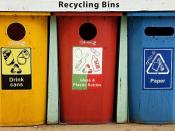Since the inception of a widespread recycling program, there have been problems hindering the full potential of energy renewal and resource reconsumption. Recycling is the reuse of materials to help reduce the waste of natural resources. Recycling has many beneficial aspects associated with it; it helps save energy, natural resources, landfill space, and money, and it also helps create jobs ("Why Recycle"). Despite all of these positive attributes of recycling, the rates at which it is occurring is severely sub par. The major problem occurring with the entire issue is not that people choose to waste all renewable materials, but more in the respect that people aren't educated enough to know the benefits of recycling. There aren't enough programs in place urging people to recycle; no law enforcement agency is pushing towards improvements in recycling. To help improve conditions dealing with this issue, an increase in education and awareness on the severity of the problem must be addressed to the group being targeted.
For this will help improve current conditions dealing with the issue. Commercial recycling is just one sector in which rates show much room for improvement
To solve the problem of public unawareness, our group set out to urge businesses to recycle. Going door-to-door, we spread the word of recycling by asking each storeowner certain questions inquiring their recycling habits. We then explained to them the benefits of recycling; how it promotes a positive image to the business, how it saves the establishment money, and how it can help reduce landfills. Providing the business with a flyer reminding them of the benefits of recycling we left the business, allowing them to reflect on what they had just learned and how they can help improve the current conditions seen today.
In examining the history of recycling in the City of Buffalo, it is necessary to understand the way recycling operates. As of December 2002, recycling has been privatized in Buffalo. The city calls for BFI Waste Management to utilize city trucks to pick up recyclables. Every citizen and business is provided with a blue recycling bin in which the can put out on the curbside for a weekly pickup by BFI. Within the last decade, the City of Buffalo has implemented a garbage user fee, which in part goes toward the recycling pick up. The city paid $1.6 billion for a five year pick-up contract with BFI. In the contract agreement, BFI kicks back $75,000 to the City of Buffalo for recycling education. Due to the current budget deficit Buffalo is unable to hire personnel to efficiently allocate these funds ( "Mayor Massiello Proposes Returning Vehicle Traffic To Main Street).
Currently, the recycling program in Buffalo has turned out an all time low in the percentage of waste that is recycled. In 1996-1997, the recycling rates in Buffalo neared 15 -20 % of total waste being recycled. When being compared to other cities of similar stature, Buffalo's recycling rates should reach near the 20% range of total waste recycled. Unfortunately, the current rates, stand far from that, at the 5 to 7% range.
At the onset of the curbside recycling initiative in Buffalo, in 1996, the Buffalo Common Council funded and established the Recycling Education Enhancement Program. Along with the program a recycling coordinator for the city was hired. With the cooperation of the recycling coordinator and the educational initiative the recycling rates in Buffalo reached an all time high in 1998. Unfortunately the funding for the Recycling Educational Enhancement Program was cut in late 1997 and since then recycling rates have dropped dramatically (Carrel).
Presently, a new initiative is being jump started by the County of Erie and the City of Buffalo to bring the recycling rate in Buffalo to an level comparable to its counterparts. The new initiative is beginning to tap into the money granted by BFI for recycling education. The goals of the program are to bring Buffalo to a recycling rate of 10% by April 1, 2004 and 20% by April 2006. If this goal is met by 2006, the City of Buffalo will create an overall savings of $400,000 (Carrel).
These goals are based on the recycling performance on other cities in New York with a similar demographic make up as Buffalo. While the recycling conditions in the city of Buffalo are appalling, the recycling rates in other cities across New York are much better. Rochester, Syracuse, and Albany are all currently running successful recycling programs. Currently residents of Rochester recycle 23.5% of their waste; Syracuse has a recycling rate of 25%, and Albany is at an 18% recycling rate. Each of the four cities receives the same amount of encouragement from New York State to recycle, and has the same rules and regulations, so why are their recycling rates so high while Buffalo's is pitifully low?
The cities' recycling plans as a whole are strikingly similar. Primarily, in accordance with New York State Law, the separation and removal of recyclable products in waste is required in each city. While the cities require recycling, they do not require that the businesses recycle through the city's program. Every commercial entity is given the option to have their waste removed by either the city or by a privately contracted company. Which ever the business chooses, they must still abide by the state's recycling requirements. Buffalo, Rochester, Syracuse, and Albany also have the same enforcement of this law. Each city can fine a person or business between one hundred and nine hundred dollars, depending on the size of the business, for failure to recycle.
Each of the four cities funds their garbage and recycling programs in very similar ways. A garbage pickup fee is charged once per year, and is dependant on the size of the garbage container used by the resident or business, the larger the container, the higher the fee. Syracuse and Rochester also charge a fee to rent the required garbage and recycling containers. However, even with the higher cost, both cities run highly effective recycling programs. For example in Rochester the commercial pick up fee for a 64 gallon tote is $405.00 annually. The city then charges an extra $155.00 for the rental of the container itself, bringing the grand total to $560.00 each year. Albany and Buffalo have a single, higher fee that includes the use of the collection bin. Both methods are effective in raising significant funding for the cities' programs.
Another similarity in the cities programs is in what can, and cannot be recycled. Glass, paper, plastic, and metal are all recyclable in each cities program. However, each differs slightly in exactly what products they will accept. Buffalo accepts paper, cardboard, metal cans, plastic bottles, newspapers, magazines, glass bottles, paper, and phone books ("Recycling Guide - City of Buffalo"). Paper, cardboard, metal cans, plastic bottles, plastic food containers, drink boxes, empty aerosol cans, newspapers, magazines, glass bottles, paper, and phone books can be recycled in Rochester (Appendix E: Collection of Recyclable Materials"). Syracuse allows plastic bottles, metal containers, glass containers, gable top containers, cardboard, newspapers, magazines, paper, Pizza boxes, and phone books to be recycled. ("OCCRA Recycling Information for Onandoga County, New York"). Finally, residents of Albany can recycle glass bottles, metal cans, motor oil, newspaper, magazines, paper, cardboard, phone books, plastic bottles, drink boxes, grass, leaves, holiday trees, and untreated wood ("Department of General Services"). All in all however, the cities collect the same basic products, and the slight differences would not attribute to a large difference in recycling rates.
There is however, one distinct difference in the programs that separates Buffalo and the other major cities in New York, a community recycling education program. Rochester, Syracuse and Albany each have some form of program that educates its residents and businesses on the importance of recycling, and how to recycle properly. Rochester runs their Recycling and Sustainability Program with both public and private funds. This program educates the public about recycling through flyers, public service announcements and regular no cost seminars ("Rochester, New York's Recycling Page"). Syracuse runs a similar program called Operation Separation. This program too uses flyers, public service announcements and seminars, but it also includes a series of programs that target school aged children, and the city also provides free recycling consultation for all businesses. ("Recycling and Waste Reduction"). Albany's education program, 'Living Responsibly With Solid Waste' is also based on public service announcements and educational fliers. ("Examples of Recycling Education Curricula"). Unlike the rest of the cities, Buffalo does not have an official recycling education program. Because all the other aspects of the cities' recycling programs are the same, the lack of an education program for its residents seems to be a large factor in the low recycling rate in the city.
While it is imperative to educate citizens and business about the social, environment, and financial benefits of recycling, it also crucial to stress importance of recycling because it is the law. "It is in the public interest...for a [business] to require the source separation and segregation of recyclable or reusable materials from solid waste " - states Section 27-0106 of the Environmental Conservation Law. If places don't comply with this law then they are subject to legal repercussions. Sure, there are tons of places that don't recycle and it is hard to enforce it, because there aren't police officers going around to every business making sure that they are recycling.
One of the first examples of laws being made on recycling was in May of 1991 when New York City businesses were required to recycle under new mandatory recycling rules. It affected around 250,000 businesses and was considered one of the largest such recycling efforts ever. Under this plan high grade office paper, corrugated cardboard, metal (cans, foil, scrap and bulk) and certain types of construction debris were the first materials that must be recycled in the first six months to establish the system. Newspapers, magazines and glass containers became mandatory after 12 months, plastic containers in 18 months, and film plastic after two years("NY Businesses to begin recycling").
However, there are cases when recycling programs haven't been implemented, and a price had to be paid. There have been few examples of where a city had to pay for not having a recycling program. One example hit pretty close to home. In Amsterdam, NY in the year 2000, they failed to reinstate their recycling program. As a repercussion, they were the first city to be sued for not maintaining a recycling program. Mayor John Duchessi Jr.'s attempt to save curbside recycling was rejected, and as a result Attorney General Eliot Spitzer filed a suit saying that the city violated a 1992 mandatory recycling law (McCann).
Recycling problems have been stated and goals for improvement have been established; but how do we fix these problems and how to we reach these goals? There is not one single solution to the issue of recycling; no one thing will remedy this problem. Many possible solutions exist; more ample funding, increased education on the issue, and more accessible recycling locations. The issue in the city of Buffalo dealing with recycling can only be solved through a combination of these possible actions. Through the education of the public on the issue of recycling, and an increase in the areas of accessible recycling receptacles, the low percentages that are clearly evident in Buffalo can be alleviated. Studies show that an increase in education and additional disposal facilities can improve the low recycling rates (Greening The Campus). With that fact in mind, the best way to increase the recycling rates is to get more bins out to the public, send flyers out on a more regularly basis, and hold public service announcements more often. According to Andrew Goldstein, the Assistant Coordinator of the Solid Waste Recycling Project in Erie County, since the city is allotted seventy-five thousand dollars ($75,000) a year solely for the advertisement and education of recycling, the city has all the funding needed to get the word out. However, it doesn't use the funds to its full advantage. The problem has more to do with lack of funding for the labor needed to carry out these actions than with the funding for the possible solutions. Since the money needed for the advertisement is out there, the city now needs to focus on acquiring the funding needed for the salaries of those who will spread the word. Therefore, the major problem with this remedy is that there is simply not enough money in Buffalo to carry out all the proposed solutions that will fix the problem. The only way that the city can possibly raise money to fund adequate personnel for the job is by raising taxes. Under the current recycling policies, residents and businesses are required to pay a garbage pick-up user fee, which also includes the pickup of recyclable materials. Since there is already a user fee (Carrel), the city can easily increase cost of the fee, in turn, raising revenue to pay the salaries of personnel that will carry out the actions to improve recycling rates. With the personnel put in place, the necessary arrangements will have been established to allow for drastic improvements in the problems with recycling in the city of Buffalo.



Reclying in Buffalo
Very interesting opinions, but needs more facts!!! Grammer is mediocre. But Overall it is okay. Again, interesting points, things we do not think about everyday.
2 out of 2 people found this comment useful.